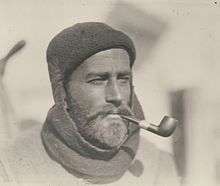Charles Hoadley
Charles Archibald Brookes Hoadley (Burwood, 1 March 1887 – Footscray, 27 February 1947) was an Australian geologist. He graduated from the University of Melbourne in 1911 with a degree in mining engineering, and was a member of the Australasian Antarctic Expedition led by Sir Douglas Mawson from 1911–14. Hoadley was a member of the Western Base Party. Cape Hoadley was named after him upon discovery by the exploration party.[1]
Charles Hoadley | |
|---|---|
 In the Antarctic | |
| Born | 1 March 1887 Burwood |
| Died | 27 February 1947 (aged 59) Footscray |
| Nationality | Australia |
| Education | University of Melbourne |
| Known for | Member of the Australasian Antarctic Expedition |
| Awards | King's Polar Medal |
| Scientific career | |
| Fields | Geology |
| Institutions | Ballarat School of Mines |
From 1914–16 he lectured in engineering at Ballarat School of Mines, before becoming the Principal at the Footscray Technical School, a post he held until his death in 1947. He was awarded the King's Polar Medal (1915) and made a Commander of the Order of the British Empire in 1936.
Scouting
In 1909, he founded one of the first Scout Groups in Footscray, Melbourne, Victoria.[2] He was Chief Commissioner of the Scout Association's Victoria Branch from 1927 to 1937, where his major achievement was the creation of Counties to take administrative duties away from Branch Headquarters. He was better known as founder and from 1924 until his death in 1947 Warden of Gilwell Park, Gembrook and a key part of Leader training, being one of the state's two first Deputy Camp Chiefs – authorised to award Scout Leaders with the Wood Badge. In 1952 the new Senior Scout competition hike was named in his honour. The former Hoadley Scout Region in western Melbourne was also named after him. He was awarded the Silver Wolf Award in 1931.
References
- "Coolantarctica Biography of Hoadley". www.coolantarctica.com. Archived from the original on 21 January 2010. Retrieved 11 July 2009.
- Williamstown Advertiser 8 July 2009.